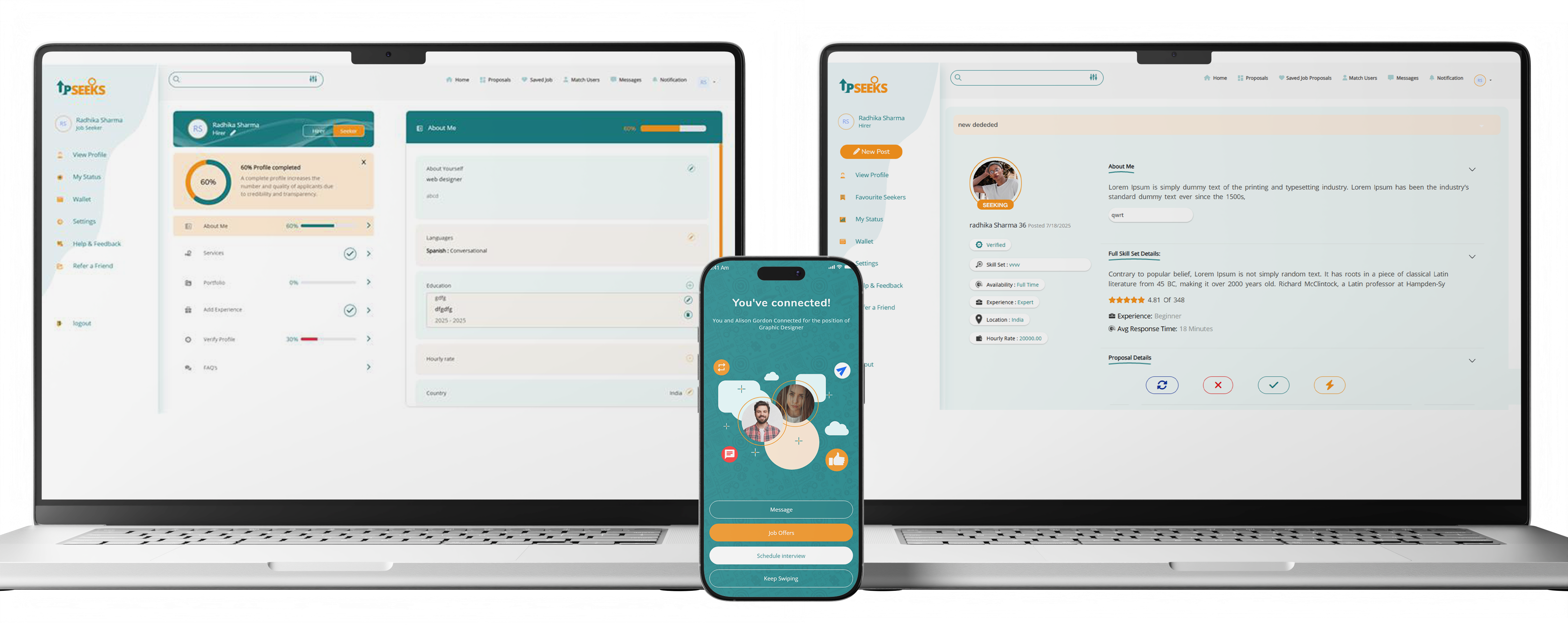Why Use Upseeks to Hire
Speed

Roles go live in minutes. Matches start appearing straight away.
Control

Filters cut noise and keep only the profiles you want.
Trust

Escrow protects your money until work is approved.
Clarity

Scopes, milestones, and reviews stay documented.
Reach

Tap into local or global talent, depending on your needs.
 Step 1. Define the Role
Step 1. Define the Role
Start in your employer dashboard. Create a new role and keep it simple:
 Job title that explains the outcome, not a vague buzzword.
Job title that explains the outcome, not a vague buzzword. Five core skills that are essential.
Five core skills that are essential. Location setting: onsite, hybrid, or remote.
Location setting: onsite, hybrid, or remote. Timeline and budget.
Timeline and budget. Deliverables you expect.
Deliverables you expect.
A good posting sets expectations. Don’t write a long essay. Short, clear points attract stronger matches.
 Step 2. Use Filters to Cut Noise
Step 2. Use Filters to Cut Noise
Filters let you decide who reaches you. You can set:
 Years of experience.
Years of experience. Tools or software knowledge.
Tools or software knowledge. Language requirements.
Language requirements. Location and time zone.
Location and time zone. ID verified only (for high-trust roles).
ID verified only (for high-trust roles).
Tight filters give you a focused shortlist. Looser filters expand your pool when speed is the priority.
 Step 3. Publish and Let Matching Run
Step 3. Publish and Let Matching Run
Upseeks uses skills, availability, and location to create a swipe deck of candidates. You don’t get hundreds of random bids. You get a clean, relevant list.
Each candidate card shows:
 Name, headline, and skills.
Name, headline, and skills. Recent reviews.
Recent reviews. Work samples or links.
Work samples or links. Availability.
Availability.
You swipe right on strong profiles and skip the rest.
 Step 4. Shortlist and Review Profiles
Step 4. Shortlist and Review Profiles
Your shortlist updates as you swipe. Open a profile to see:
 Verified ID badge if completed.
Verified ID badge if completed. Previous roles and outcomes.
Previous roles and outcomes. Portfolio files or links.
Portfolio files or links. Review scores for quality, speed, and reliability.
Review scores for quality, speed, and reliability.
Look for results that match your scope. Skip vague profiles with no proof of work.
 Step 5. Start the Conversation
Step 5. Start the Conversation
Open chat with your shortlisted candidates. Keep the first exchange simple. Ask three clear questions:
 What similar project have you done before?
What similar project have you done before? Which tools did you use?
Which tools did you use? When are you ready to start?
When are you ready to start?
Direct questions get direct answers. Long back-and-forth wastes time.
 Step 6. Agree Scope and Milestones
Step 6. Agree Scope and Milestones
Turn your conversation into a written scope:
 What needs to be delivered.
What needs to be delivered. When it needs to be delivered.
When it needs to be delivered. How much will be paid.
How much will be paid. What counts as approval.
What counts as approval.
Break the work into milestones if it’s more than a week long. Example: design draft, build stage, final delivery. Each milestone gets funded and released separately.
 Step 7. Protect the Work with Escrow
Step 7. Protect the Work with Escrow
Before work begins, fund the first milestone. Money goes into escrow. The freelancer sees that payment is secured, but they only receive it once you approve the work.
Escrow gives both sides confidence:
 You’re not at risk of paying before delivery.
You’re not at risk of paying before delivery. They’re not at risk of working without being paid.
They’re not at risk of working without being paid.
If there’s a dispute, Upseeks reviews the chat, scope, and files to make a fair decision.
 Step 8. Review and Repeat
Step 8. Review and Repeat
Once a milestone is complete:
 Review the work.
Review the work. Release funds.
Release funds. Leave feedback that’s fair and specific.
Leave feedback that’s fair and specific. Save strong talent to your private list.
Save strong talent to your private list.
Next time you post, you can go straight back to people you’ve worked with before.
Best Practices for Stronger Hires
-
 Write outcomes, not tasks. Example: “Deliver a landing page live in WordPress” is better than “Work on website.”
Write outcomes, not tasks. Example: “Deliver a landing page live in WordPress” is better than “Work on website.” -
 Limit must-have skills. Stick to five maximum. Too many filters drive away good candidates.
Limit must-have skills. Stick to five maximum. Too many filters drive away good candidates. -
 Ask for samples. One real example says more than ten buzzwords.
Ask for samples. One real example says more than ten buzzwords. -
 Test when needed. For critical roles, set a short paid trial task.
Test when needed. For critical roles, set a short paid trial task. -
 Communicate in-platform. Keep all chat and file sharing inside Upseeks for protection.
Communicate in-platform. Keep all chat and file sharing inside Upseeks for protection.
Legal and Compliance Basics
-
 Direct Contracts are for one-off tasks.
Direct Contracts are for one-off tasks. -
 Contract-to-Hire lets you trial someone for a few weeks before offering a full-time role.
Contract-to-Hire lets you trial someone for a few weeks before offering a full-time role. -
 Intellectual property rights transfer once payment is released.
Intellectual property rights transfer once payment is released. -
 Invoices and receipts are stored in your dashboard.
Invoices and receipts are stored in your dashboard. -
 For taxes or employment law, consult your local advisor.
For taxes or employment law, consult your local advisor.
Security and Trust
-
 ID checks reduce risk.
ID checks reduce risk. -
 Stripe Connect processes all payments securely.
Stripe Connect processes all payments securely. -
 Data is encrypted at rest and in transit.
Data is encrypted at rest and in transit. -
 Reviews and ratings focus on recent performance, not old history.
Reviews and ratings focus on recent performance, not old history.
Metrics to Track
Good employers track results, not guesses. Watch:
-
 Time to shortlist.
Time to shortlist. -
 Time to hire.
Time to hire. -
 Approval rate on first milestones.
Approval rate on first milestones. -
 Cost per hire.
Cost per hire. -
 Retention after 30 and 90 days.
Retention after 30 and 90 days.
These numbers show if your scopes and filters are working.
FAQs
 Q. How fast do matches appear?
Q. How fast do matches appear?
Matches update daily as new talent joins. With strict filters, you’ll see fewer but stronger profiles.
 Q. What fees apply?
Q. What fees apply?
Employer subscription plans are shown on the Pricing page. Escrow has a small fee per milestone, split fairly between both sides.
 Q. What if work is late?
Q. What if work is late?
You can extend the milestone date in the dashboard. Always document changes in chat. Only fund the next step after the current one is approved.

